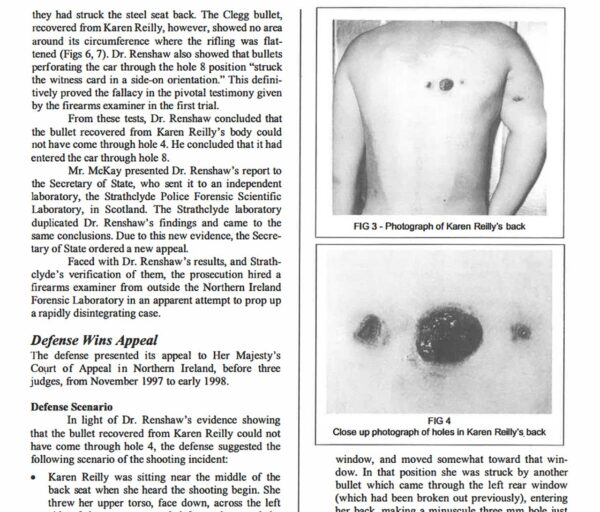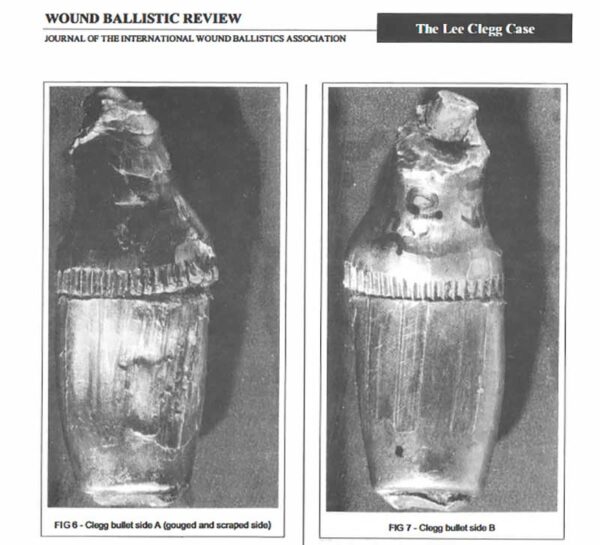OpinionYou can learn the in-depth article on the Lee Clegg Homicide Case within the archived model of WOUND BALLISTIC REVIEW, The Lee C Legg Case Vol 4 Spring 2000 Quantity 3, discovered right here.
In a world the place we’re continually instructed to “belief the science,” the Lee Clegg case is a sobering reminder of what occurs when science is manipulated to serve a political agenda — and the way simply even “consultants” can idiot themselves after they cease questioning their very own conclusions.
This aint just a few previous British court docket case. It’s a case research of what occurs when the scientific methodology is deserted, details are ignored, and egos get in the way in which of fact. It’s additionally a lesson for anybody who values fact, due course of, and the significance of proof over narrative — particularly in conditions involving the usage of power, whether or not by troopers, cops, or civilians.
The Capturing: A Tragic Incident, A Rushed Narrative
On September 30, 1990, British Paratrooper Personal Lee Clegg was manning a checkpoint in Belfast, Northern Eire. A stolen Vauxhall Astra sped by way of the checkpoint at excessive pace. Members of the patrol opened hearth. Karen Reilly, a 17-year-old passenger within the rear seat, was struck and killed by gunfire.
A bullet recovered from her physique was matched to Personal Clegg’s rifle. The prosecution’s idea was that the deadly bullet had entered by way of the rear seat again — a shot fired after the automobile was already fleeing, not posing a risk.
If true, that meant Clegg didn’t hearth in self-defense — he fired in revenge, and that will make it homicide.
That idea turned the inspiration of the trial. However it was based mostly on shaky assumptions — and the “professional” testimony used to convict him was by no means correctly examined.
The Skilled Who By no means Examined His Principle
At trial, a firearms examiner from the Belfast Criminalistics Laboratory testified unequivocally that the deadly bullet had come by way of the rear of the automobile, by way of a gap within the seat labeled “gap 4.” He claimed the bullet couldn’t have yawed (wobbled) quick sufficient after coming by way of the aspect door (gap 8) to make the rectangular entry wound seen in Reilly’s physique.
However right here’s the kicker: he by no means performed a single check to show any of that.
His claims had been accepted as reality — with out peer-reviewed information, with out check firings, with out something however his personal opinion. And much more surprising: the protection didn’t problem his conclusions on the unique trial.
Clegg was convicted of homicide in 1993.
The Bullet Informed a Completely different Story

Years later, a scientist named Dr. Graham Renshaw, with a Ph.D. in bodily chemistry, was introduced in to really check what the prosecution by no means did.
Utilizing the identical kind of automobile and bullets, Dr. Renshaw recreated the pictures utilizing high-fidelity setups. He positioned witness playing cards to trace bullet yaw and caught projectiles in cotton so that they might be examined with out deformation.
What he discovered destroyed the prosecution’s case.
Bullets fired by way of the rear seat again (gap 4) in a side-on (yawed) place at all times confirmed flattened rifling marks or fragmentation.
The bullet pulled from Karen Reilly’s physique — the one matched to Clegg’s rifle — had none of those flattening marks. Its rifling impressions had been nonetheless raised and intact round its circumference.
The bullet additionally confirmed uneven pushback of the copper jacket — not the type of symmetrical deformation you’d count on from a straight-on impression just like the rear seat. As a substitute, this urged the bullet got here by way of the aspect of the automobile, hanging at an angle.
Tip-to-tail scraping and gouging on the bullet matched what you’d see from a bullet going by way of the aspect door and ashtray (gap 8), not from hanging a metal seat again sideways.
These weren’t opinions — they had been measurable, bodily details backed by reproducible checks.

Even Their Personal Lab Agreed
When Dr. Renshaw’s findings had been submitted to the UK’s Secretary of State, they had been reviewed by the Strathclyde Police Forensic Laboratory — an impartial forensic workforce in Scotland. They duplicated Renshaw’s checks and reached the identical conclusions.
Confronted with a crumbling narrative, the prosecution responded not with humility — however with a determined try to save lots of face.
They introduced in an outdoor firearms examiner who flooded the court docket with over 600 pages of stories, charts, movies, and half-explained experiments. As a substitute of addressing the core details — the bodily situation of the Clegg bullet — this new “professional” buried the courtroom in complexity and confusion.
However science doesn’t care how thick your binder is.
What They Didn’t Wish to Admit
Regardless of all of the noise, some truths had been plain:
The Clegg bullet couldn’t have made the opening within the metal rear seat (gap 4) — it merely lacked the flattening and deformation each bullet confirmed when that shot was recreated.
The bullet matched the conduct of 1 getting into from the aspect door (gap 8), which might have occurred whereas the automobile was nonetheless a risk.
The prosecution tried to assert a tiny metal “cap” present in a wound proved the bullet got here by way of gap 8 — however photographic proof confirmed it was resting at pores and skin stage, not embedded, that means it wasn’t carried in by a high-speed bullet.
Even the prosecution’s pathologist did not take X-rays of Reilly’s physique throughout the post-mortem — a serious oversight. Which means bullets or fragments might have remained undiscovered.
Justice (Lastly) Prevails
Clegg’s conviction was finally overturned on enchantment in 1998. A brand new trial was held, and regardless of continued makes an attempt by the prosecution to revive their flawed theories, the proof might not be ignored.
The court docket dominated that the prosecution had not confirmed its case, and Clegg was cleared of homicide. However the harm was already finished. He had spent years in jail, his fame shattered, and solely after an extended and dear battle was the reality allowed to floor.
What This Means for Us
Gun house owners know higher than most how narratives can be utilized towards individuals who defend themselves. We’ve seen it repeatedly — whether or not it’s biased media protection, manipulated information, or anti-gun “consultants” paraded earlier than juries to testify towards widespread sense.
The Lee Clegg case is a warning. Skilled opinion is just not proof. Scientific authority means nothing with out clear strategies, reproducible outcomes, and a willingness to confess if you’re incorrect.
This wasn’t simply dangerous science — it was biased science. It exhibits how simple it’s to swap goal evaluation for ego and politics — particularly in instances involving use of power, whether or not in conflict, regulation enforcement, or self-defense at dwelling.
Remaining Thought
As Dr. Fackler places it: “We should be taught from our errors, we should educate ourselves to assist those that err by suggesting to them attainable causes for his or her misinterpretations.”
Science ought to serve the reality — not bury it. And if we ever need to defend our rights, our freedoms, and our folks, we have to maintain questioning, maintain testing, and by no means cease asking an important query of all:
“Am I fooling myself?”
As a result of as soon as consultants cease asking that, the subsequent harmless man might be you.
IMG WOUND BALLISTIC REVIEW The Lee C Legg Case Vol 4 Spring 2000 Quantity 3
The Battle for Armed Self-Protection in New York: A System Rigged In opposition to Residents
Estonia Supreme Courtroom Guidelines In-Favor of Cheap Self Protection
About Thomas Conroy
Thomas Conroy is a firearms aficionado and author who lives within the Midwest.
A few of the hyperlinks on this web page are affiliate hyperlinks, that means at no extra value to you, Ammoland will earn a fee when you click on by way of and make a purchase order.





















